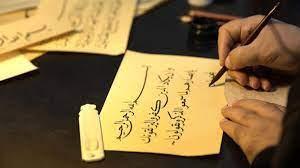
Hüsn-i Hat, known as Ottoman-style traditional calligraphy art, has been added to the UNESCO list of Intangible Cultural Heritage of Humanity, according to a statement released by Turkish Foreign Ministry.
“Our national nomination file of ‘Hüsn-i Hat, Traditional Calligraphy in Islamic Art in Turkiye’ has been inscribed on the UNESCO Representative List of Intangible Cultural Heritage of Humanity,” the statement said.
“We will decisively continue to preserve, cherish and promote our rich cultural values inherited from our deep-rooted history,” it added.
The number of the country’s cultural elements inscribed on the UNESCO lists has reached 21 following the move, making Turkey one of the top five countries to register the most items on the lists.
The Hüsn-i Hat is the centuries-old practice of writing letters of Arabic origin in a measured and proportional manner while taking into consideration certain aesthetic values.
Traditional tools include a specific type of paper glazed with organic substances, a reed pen, pen knives, a special slab for trimming the reed pen, an inkwell, soot ink and a pen case.
Many calligraphers, or hattats, make their own tools, and they play an important role in the transmission of the Hüsn-i Hat tradition, passing on their knowledge, craft skills and values through apprenticeships.
Being able to be written on paper of leather, The Hüsn-i Hat may also be applied on stone, marble, glass and wood, among others.
There are many different styles of the prominent art, and the practice was traditionally used to write the Quran, remarks of the Islamic Prophet Muhammad and poetry, as well as for Ottoman state’s correspondence, such as imperial edicts and warrants, and on religious and public buildings.
To this day, Hüsn-i Hat is still used in sacred and literary works and on mosques and other religious places as well as Turkish baths.
Meanwhile, UNESCO also recognized Arabic calligraphy, the artistic practice of handwriting based on the Arabic alphabet, as an intangible cultural heritage on the same day.
A total of 16 Muslim-majority countries, led by Saudi Arabia, presented the nomination to UNESCO, which announced the listing on Twitter.
“Arabic calligraphy is the artistic practice of handwriting Arabic script in a fluid manner to convey harmony, grace and beauty,” UNESCO said on its website.
“The fluidity of Arabic script offers infinite possibilities, even within a single word, as letters can be stretched and transformed in numerous ways to create different motifs,” it noted.